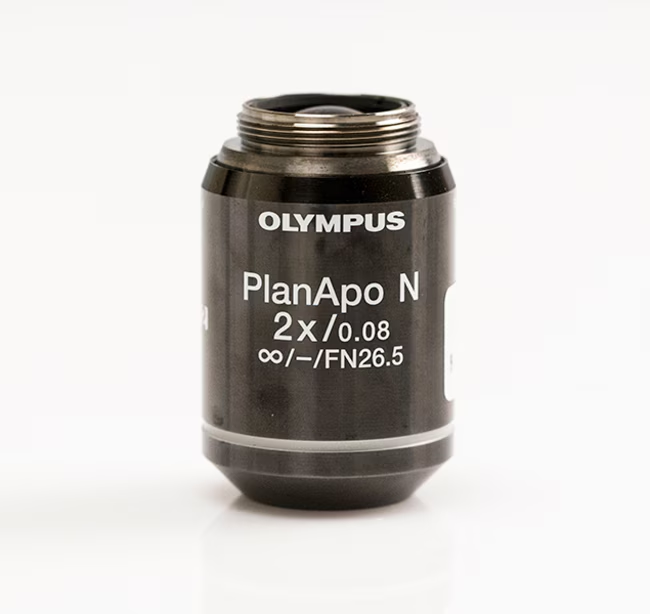
This apochromat objective is ideal for the most demanding applications, especially capturing color images in white light. This is a long working distance (LWD) objective that is optimized for the imaging of slides, cell culture dishes and flasks, and microtiter plates. All Olympus objectives are compatible with EVOS Cell Imaging systems and offer outstanding optical performance from visible light to near infrared light. The extensive choice of EVOS and Olympus objectives satisfies needs across the spectrum of magnifications and optical specifications.
Additional characteristics of this Olympus objective:
• Magnification: 2X
• Numerical Aperture: 0.08
• Working Distance: 6.22 mm
Image Quality
Microscope objectives may be the most important components of an optical microscope because they are responsible for primary image formation. Image quality is crucial to experimental success and a requirement for publication. Olympus objectives are widely recognized for their quality and performance across the visible spectrum to near infrared light. The broad selection of EVOS and Olympus objectives means you have a range of options for your imaging requirements.
Objective Classes
Achromat objectives are perfect for general applications, with standard correction of color and focus.
Fluorite objectives deliver excellent resolution and are made with higher numerical apertures than achromat objectives, resulting in brighter fluorescence signal and higher contrast imaging. The higher optical quality greatly reduces optical aberrations, and corrections for color and focus are at higher levels than achromat objectives. Fluorite objectives are ideally suited for fluorescence and demanding transmitted light applications, where the higher contrast make them ideally suited for color imaging.
Apochromat objectives are manufactured to the highest levels of resolution, fluorescence brightness, and contrast; chromatic aberrations are almost eliminated. They are recommended for the most demanding applications, particularly at magnifications of 60x and above. Apochromatic objectives are the best choice for the capture of color images in white light.
Brightfield Contrast versus Phase Contrast Objectives
Brightfield is the most basic form of light microscopy and is accomplished by sample absorption of light. A higher density area in a sample will absorb more light, thus increasing contrast in those areas. Phase contrast objectives are most useful for hard to see, translucent specimens. This method of contrast is accomplished by converting phase shifts, caused by light passing through a translucent specimen, into brightness changes (i.e., contrast).
Long Working Distance versus Coverslip-Corrected Objectives
Long working distance (LWD) objectives are optimized for use through vessels with a nominal wall thickness of 0.9-1.5 mm. This includes vessels commonly used in cell culture and cell-based assays, such as slides, cell culture dishes and flasks, microtiter well plates, etc. Coverslip-corrected objectives are optimized for use through #1.5 coverslips (thickness approximately 0.17 mm). These objectives have a higher magnification/NA ratio and provide higher resolution compared to LWD objectives.
For additional choices, visit the EVOS & Olympus objectives selection guide
Explore the entire EVOS line of imaging systems and accessories
| Code | Description |
|---|---|
| AMEP4751 | Catalog Number: AMEP4751 |

